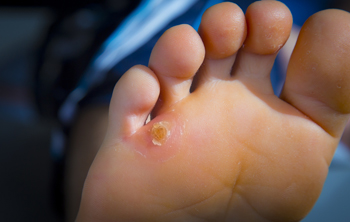
Corns are thickened areas of skin that develop in response to repeated pressure or friction, often from wearing ill-fitting shoes or abnormal walking patterns. They typically form on the tops and sides of toes or on the soles of the feet. Common causes include wearing tight footwear, high heels, or walking without proper support. There are different types of corns, including hard corns, soft corns found between the toes, and seed corns which appear on the bottom of the foot. While small corns may not cause pain, larger ones can become uncomfortable or lead to further irritation. A podiatrist can identify the cause, safely remove corns, and recommend footwear or custom orthotics to relieve pressure and prevent recurrence. If you have developed a corn, it is suggested that you confer with a podiatrist who can offer effective relief and treatment solutions.
If you have any concerns regarding your feet and ankles, contact George Tellam, DPM of Ankle & Foot Associates. Our doctor will treat your foot and ankle needs.
Corns: What Are They? and How Do You Get Rid of Them?
Corns can be described as areas of the skin that have thickened to the point of becoming painful or irritating. They are often layers and layers of the skin that have become dry and rough, and are normally smaller than calluses.
Ways to Prevent Corns
There are many ways to get rid of painful corns such as wearing:
- Well-fitting socks
- Comfortable shoes that are not tight around your foot
- Shoes that offer support
Treating Corns
Treatment of corns involves removing the dead skin that has built up in the specific area of the foot. Consult with Our doctor to determine the best treatment option for your case of corns.
If you have any questions please feel free to contact our offices located in Orange Park and Jacksonville Beach, FL . We offer the newest diagnostic and treatment technologies for all your foot and ankle needs.

Gout is a form of inflammatory arthritis that can affect women, particularly after menopause when protective hormone levels decline. Causes include high levels of uric acid in the blood, which form sharp crystals in joints. Risk factors include genetics, obesity, certain medications, and diets high in red meat or alcohol. Symptoms often appear suddenly and include intense pain, redness, swelling, and warmth in the affected joint, commonly the big toe. The pain can be severe, causing difficulty in walking, and may limit daily activities. A podiatrist can help manage gout through medication, lifestyle guidance, and joint care. If you are experiencing sudden foot pain or swelling, it is suggested that you seek professional evaluation from a podiatrist who can help you to manage this painful condition.
Gout is a foot condition that requires certain treatment and care. If you are seeking treatment, contact George Tellam, DPM from Ankle & Foot Associates. Our doctor will treat your foot and ankle needs.
What Is Gout?
Gout is a type of arthritis caused by a buildup of uric acid in the bloodstream. It often develops in the foot, especially the big toe area, although it can manifest in other parts of the body as well. Gout can make walking and standing very painful and is especially common in diabetics and the obese.
People typically get gout because of a poor diet. Genetic predisposition is also a factor. The children of parents who have had gout frequently have a chance of developing it themselves.
Gout can easily be identified by redness and inflammation of the big toe and the surrounding areas of the foot. Other symptoms include extreme fatigue, joint pain, and running high fevers. Sometimes corticosteroid drugs can be prescribed to treat gout, but the best way to combat this disease is to get more exercise and eat a better diet.
If you have any questions please feel free to contact our offices located in Orange Park and Jacksonville Beach, FL . We offer the newest diagnostic and treatment technologies for all your foot and ankle needs.

Flat feet, also called fallen arches, can contribute to foot, ankle, and lower leg discomfort due to poor arch support and misalignment. In some cases, a series of exercises for flat feet may help strengthen the arch and surrounding muscles. These include movements that raise the arch, such as controlled heel lifts and arch raises, which help activate the muscles on the inside of the foot. Toe-based exercises may also be advised to improve strength in the forefoot and toes. A podiatrist may suggest specific routines that target foot posture and stability, including stair-based arch lifts or exercises using resistance like towel curls. These activities work to improve arch height and may reduce stress on the foot structure. In more severe cases, custom orthotics or surgery also may be considered. A podiatrist can evaluate the structure of your feet and design a treatment that improves function and relieves discomfort. If you have pain from flat feet, it is suggested that you schedule an appointment with a podiatrist for appropriate treatment.
Flatfoot is a condition many people suffer from. If you have flat feet, contact George Tellam, DPM from Ankle & Foot Associates. Our doctor will treat your foot and ankle needs.
What Are Flat Feet?
Flatfoot is a condition in which the arch of the foot is depressed and the sole of the foot is almost completely in contact with the ground. About 20-30% of the population generally has flat feet because their arches never formed during growth.
Conditions & Problems:
Having flat feet makes it difficult to run or walk because of the stress placed on the ankles.
Alignment – The general alignment of your legs can be disrupted, because the ankles move inward which can cause major discomfort.
Knees – If you have complications with your knees, flat feet can be a contributor to arthritis in that area.
Symptoms
- Pain around the heel or arch area
- Trouble standing on the tip toe
- Swelling around the inside of the ankle
- Flat look to one or both feet
- Having your shoes feel uneven when worn
Treatment
If you are experiencing pain and stress on the foot you may weaken the posterior tibial tendon, which runs around the inside of the ankle.
If you have any questions please feel free to contact our offices located in Orange Park and Jacksonville Beach, FL . We offer the newest diagnostic and treatment technologies for all your foot and ankle needs.

